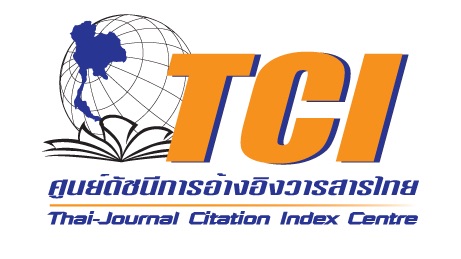รูปแบบการเรียนรู้แบบประสบการณ์ของนักศึกษามหาวิทยาลัยราชภัฏศรีสะเกษ รายวิชาภาษาอังกฤษพื้นฐาน 1 สำหรับนักศึกษาวิชาเอกสังคมศึกษา
Abstract
การวิจัยครั้งนี้มีวัตถุประสงค์เพื่อศึกษารูปแบบการเ ของนักศึกษาภาคปกติที่ลงทะเบียนเรียนรายวิชาภาษาอังกฤษพื้นฐาน โดยใช้ระเบียบวิธีการวิจัยเชิงปริมาณและเชิงคุณภาพ ในการศึกษา กลุ่ หมายที่ใช้ในการวิจัยคือนักศึกษาวิชาเอกสังคมศึกษาชั้นปีที่ 1 ที เรียนรายวิชาภาษาอังกฤษพื้นฐาน 1 ภาคเรียนที่ 2/2557 เครื่องมือที่ ทดลองได้แก่ แบบฝึกภาษาอังกฤษแบบประสบการณ์ จำนวน 5 ชุด เครื่อง มือที่ใช้ในการการเก็บรวบรวมข้อมูลเป็นแบบสังเกต และแบบสอบถาม การวิเคราะห์ข้อมูลแบบสอบถามความคิดเห็นของผู้เรียนที่มีต่อการ ด้วยชุดกิจกรรมการเรียนรู้แบบประสบการณ์ใช้วิธีหาค่าเฉลี่ยร้ ส่วนแบบสังเกตพฤติกรรม นำเสนอข้อมูลแบบบรรยาย ผลการวิจัย พบว่านักศึกษาทุกคนที่เรียนด้วยชุดกิจกรรม เรียนรู้แบบประสบการณ์ เห็นด้วยเป็นอย่างยิ่งว่า ชุดกิจกรรมการเร แบบประสบการณ์ช่วยทำให้นักศึกษามีปฏิสัมพันธ์กับเพื่อนร่วม ทำให้นักศึกษารู้จักนำคำศัพท์ภาษาอังกฤษที่ได้เรียนมา มาใช้แ เพื่อสนทนา ทำให้นักศึกษาสามารถแต่งบทสนทนาเป็นภาษาอังกฤษได้ ทำให้นักศึกษาสามารถสรุปความรู้ที่ได้รับอย่างมีแบบแผน ทำให้สามารถแสดงบทบาทสมมุติให้ผู้อื่นชมได้ ทำให้นักศึกษากล้าแสดงอ นอกจากนี้นักศึกษายังเห็นด้วยว่าชุดกิจกรรมการเรียนรู้แบบประสบการณ์ มีกิจกรรมที่หลากหลาย ทำให้ได้รับความรู้ตามที่ต้องการ ให้ช่วยทำนักศึกษาเกิดความชำนาญในการใช้ภาษาอังกฤษให้นักศึกษามีความรอบรู้ในวิชาภาษาอังกฤษมากขึ้น จากการสังเกตพฤติกรรมหลังจากการใช้ชุดกิจกรรมการเรียนรู้ แบบประสบการณ์ แล้วพบว่า นักศึกษาส่วนใหญ่ สามารถออกเสียงคำ ศัพท์ภาษาอังกฤษได้ถูกต้อง สามารถเลือกใช้คได้เหมาะสมกับสถานการณ์ ำ สามารถพูดภาษาอังกฤษได้ถูกต้องตามโครงสร้างประโยค ในขณะที่จำนวน นักศึกษาบางส่วนที่สามารถสื่อสารด้วยภาษาอังกฤษอย่างเป็นธรรมชาต และมีนักศึกษาส่วนน้อยที่สามารถปรับแต่งบทสนทนาได้เหมาะสม
This research aimed to study The experiential learning model of the students registered in Foundation of English 1 of the first year students of social studies major, Sisaket Rajabhat University, Sisaket Province. The population of this research were 31 students who studied the subject of Foundation of English 1 in the academic year 2014. Data were collected through questionnaires and analyzed by percentage and frequency. The study showed that all students who studying from Experiential Learning Activities agreed that they helped them to interact with their friends, used vocabularies correctly in conversations. Students could perceive, summarize the knowl-edge orderly and they dared to present and did the role play in front of audiences. Moreover, they agreed that the Experiential Learning Activities had also many materials and activities, master on learning, and gained knowledge of English. After using the Experiential Learning Activity, the study revealed that, most of the students could pronounce words, select words correctly, and speak with correct grammatically sentences. On the other hand, some of the students could speak English naturally, and less number of them could create their own conversation appropriately.
References
ทิศนา แขมมณี. (2550). ศาสตร์การสอน : องค์ความรู้เพื่อการจัดการ กระบวนการเรียนรู้ที่มีประสิทธิภาพ. (พิมพ์ครั้งที่ 5). กรุงเทพฯ สำนักพิมพ์แห่งจุฬาลงกรณ์มหาวิทยาลัย.
Carrell, P.L. & Eisterhold, J.C. (1983). Schema theory and ESL reading pedagogy. TESOL Quarterly, 17, 553-569. Cottrell, Stilla. (2003). Critical Thinking Skills. Basingstoke:Palgrave Macmillan.
Filipczak, B. “Putting the Learning into Distance Learning.” TRAINING 32, no. 10 (October 1995): 111-118. (EJ 511 253)
James E. Duane. (1973). Individualized Instruction Prgrams and Materials. New Jersey : Educational Technology Publications Englewood Cliffs.
Knight, P. (2001). The development of EFL methodology. In C. Candlin & N. Mercer (Eds.), English language teaching in its social context. New York: Routledge.
Kolb, A.D., (1984). Experiential learning. Retrieved 25 No vember 2014 from http://www.infed.org/biblio/b-ex plrn.htm.
Long, M. H., & Porter, P. (1985). Group work, interlanguage talk, and second language acquisition. TESOL Quar terly 19, 2, 207-27.
Scrivener, J. (1998). Learning Teaching. Oxford: Macmillan Heinemann.
Downloads
Published
How to Cite
Issue
Section
License

This work is licensed under a Creative Commons Attribution-NonCommercial-NoDerivatives 4.0 International License.







